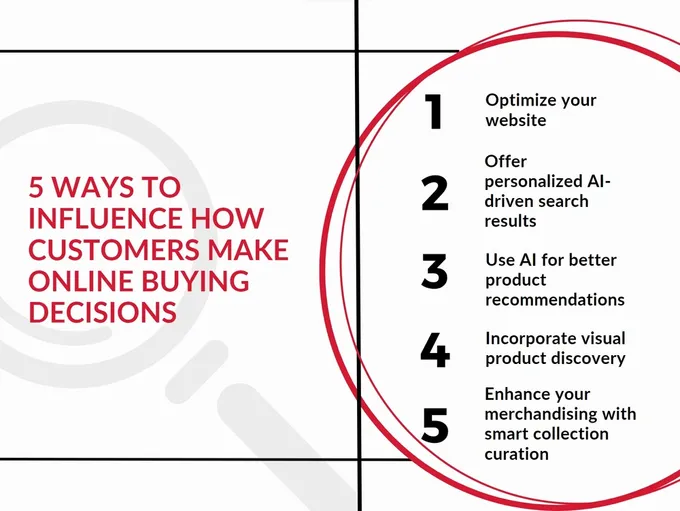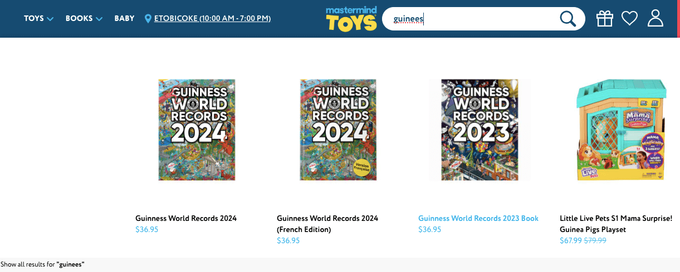5 Ways to Influence How Customers Make Online Buying Decisions
Help your customers find and buy what they want using these technology-driven strategies.
Updated November 19, 2024.

The annual revenue in the eCommerce industry is expected to clear a trillion dollars by 2028, and many ambitious merchants are looking to capitalize on its fast growth. This steep trend means there are more factors than ever that can sway a customer’s decision to buy or abandon your store entirely.
So, let's take a closer look at how online shopping has evolved and the five key eCommmerce tactics your store needs to keep customers happily purchasing.
» Looking to stay ahead of the curve? Discover how to incorporate AI into your online store
Meet the Expert
Sandra Stepan, co-founder of SnapAdvantage, has 10 years in digital marketing, focusing on e-commerce expansion. With success in building 7-figure brands, she amplifies growth for top brands. An industry leader, Sandra is a trusted expert for marketing excellence.
Evolution of Online Shopping
In its early stages, online shopping was characterized by novelty and convenience, although customers remained cautious. Naturally, there were concerns about security and the absence of an in-person shopping experience.
The Effect of Technology
Technological advancements and the introduction of secure payment options played a pivotal role in reshaping perceptions of online shopping. This shift fostered trust and diversity, laying the foundation for the online shopping landscape we know today.
In the modern world, the advent of smartphones has further revolutionized the game. Consumers can now shop from anywhere, be it at home, during work breaks, or while commuting.
Building Communities Between Shoppers and Sellers
Online shopping has quickly become an immersive experience for consumers and a strategic opportunity for companies and brands. The focus has shifted towards providing a personalized and engaging experience.
Online shopping is no longer solely about buying items; it's about creating a connection between the consumer and the brand. Personalized recommendations are like a knowledgeable friend anticipating your preferences, and are expected to be seamlessly integrated into the online shopping experience.
» Growing your personalization strategy? Here's how to add personalization to your Shopify store
5 Ways to Influence How Customers Make Online Buying Decisions
1. Optimize Your Website
A poorly optimized website creates an uncomfortable experience for the customer, which is sure to chase them away from your store for good. In this age, customers expect certain features and generally won't settle for anything less.
Here are some things to keep in mind:
- Page load speed: Fast-loading pages significantly enhance conversion rates as modern shoppers prioritize swift access over sluggish loading times. Anything longer than two seconds could be too much.
- Mobile responsiveness: Optimizing websites for mobile devices is crucial, considering the prevalent use of smartphones for online shopping.
- User-friendly navigation: Intuitive layouts guide customers through purchasing decisions and make it easier to find what they're looking for, contributing to a seamless and delightful shopping experience.
- Efficient checkout process: A streamlined checkout with minimal friction is imperative to prevent abandoned carts and ensure successful conversions.
» Need help enhancing your site? Discover how to create an optimized design for your eCommerce store
2. Offer Personalized AI-Driven Search Results
eCommerce platforms use AI to understand user intent, offering personalization in their site search results and autocomplete suggestions.
By offering autocomplete suggestions and personalized results, these search engines make it easier for customers to find what they're looking for, even in cases of typos or vague queries. This level of personalization and customer anticipation contributes to a smoother and more efficient search process.
For example, Mastermind Toys uses AI in their eCommerce search functionality to predict the most relevant results, even when search queries are incorrectly spelled.
3. Use AI for Better Product Recommendations
Artificial Intelligence (AI) has revolutionized online shopping by offering personalized recommendations based on customer behavior. Analyzing past purchases and browsing history allows businesses to upsell and cross-sell with personalized product recommendations, expediting the customer's journey.
AI-driven suggestions lead to a more streamlined shopping experience, improving conversion rates and average order values.
» Learn more about creating personalized product recommendations
4. Incorporate Visual Product Discovery
Interactivity and visual appeal contribute to an overall improved user experience making the online shopping journey enjoyable and satisfying. AI-driven visual discovery can reduce the likelihood of bounce rates by allowing customers to visualize what the product actually looks like and better understand its design, texture, and quality, and are more enticing than simple text.
Consider the following:
- High-quality product images and videos: Compelling visuals that are high quality build trust and engagement, fostering trust and encouraging conversions, while poor-quality visuals can deter potential customers.
- 360-degree visuals and videos: This interactive and immersive experience can lead to a deeper connection with the product.
- Visual search: Allowing customers to find suitable products by uploading an image of a similar product (without any text!) is a great way to offer an alternative search option that's fun and intuitive.
» Still confused? Here's how eCommerce brands use visual search to improve product discovery
5. Enhance Your Merchandising With Smart Collection Curation
Using smart collections is a strategic approach to organizing and presenting products within an online store. This method enhances merchandising by thoughtfully grouping items. Grouping is based on trends, seasons, occasions, or user behavior.
The key aspects of smart collection curation include:
- Themes and trends in the market: Enhance the visibility of products that align with popular consumer preferences, driving engagement and sales.
- Seasonal collections: Allow customers to easily discover and explore items suitable for specific times of the year or special events. You won't want to recommend winter coats in the middle of summer!
- User behavior consideration: Adapt collections based on observed user interactions and preferences on the website.
Fast Track Your Way to Streamlined Customer Journeys
We've taken a good, hard look into the evolution of online shopping. This includes the power of personalization and search algorithms. We’ve also delved into the precision of AI-driven recommendations and the visually engaging journey of product discovery.
These techniques can streamline the customer journey. They simplify the purchasing process. Additionally, they can boost your average order value through personalized recommendations.







